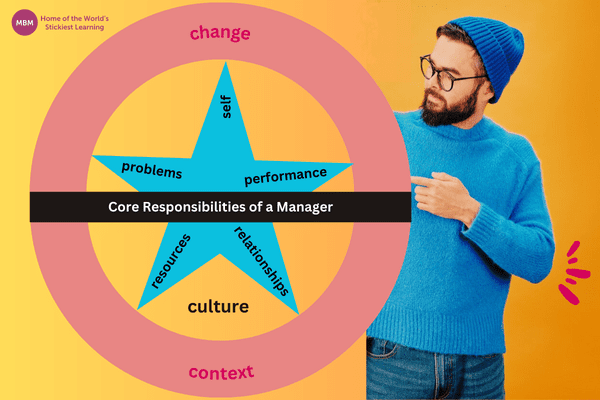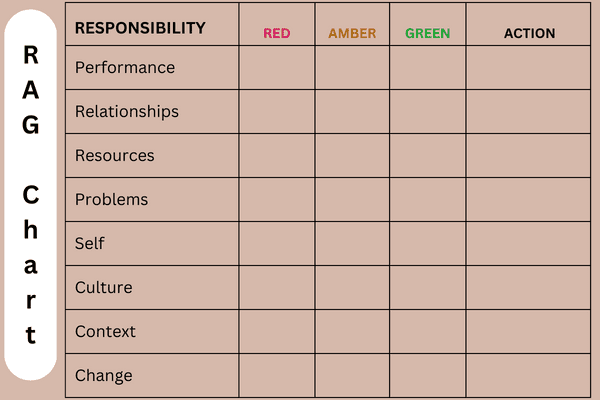Unveiling the Secrets to Becoming an Exceptional Line Manager
This article is intended as a guide for anyone who aspires to become a manager; for anyone who is a first-time manager; and for any existing manager that wants to check their current roles and responsibilities. So if you’re looking at how to be a good line manager, you’ve come to the right place.
Firstly, the modern line manager has the following key responsibilities:
- Managing performance.
- Managing relationships.
- Managing resources.
- Managing problems.
- Managing self.
- Managing context, culture, and change.
These can be represented in the diagram further below.
The 5-point star represents the 5 core responsibilities of any manager. But what is expected of those 5 roles and responsibilities will vary and be shaped by the other three factors. These other three factors are the internal culture, the context within which the organisation is operating, and the changes that are continually required.

So as you look at the diagram and the 8 core responsibilities, check:
- How would I assess my personal competence in each role?
- How much of my management activity is taken up or dominated by any of these 8 responsibilities?
- Do I give, or need to give, a more balanced allocation to these 8 roles?
- Am I neglecting any of them – and if so, why?
- Which, if any, are my priorities for any further development?
Now, to help you answer these questions, here are some of the detailed requirements of each role…
1: Managing Performance

In understanding how to be a good line manager, there are 4 levels of performance any manager may need to be responsible for:
- The larger unit (department, for example).
- The team or teams (within the department).
- The individuals within each team.
- Themselves.
Key Tips for Managing Performance:
In terms of their performance, the manager should be able to:
- Set and quantify performance requirements, perhaps using the SMART model (specific, measurable, achievable, relevant and time-framed). To do this, be more outcome-focused than activity focused. Moreover, ensure everyone knows how their daily to-do list of activities contributes to overall outcomes.
- Provide the necessary resources to allow those requirements to be met – such as money, time, equipment, and training.
- Identify and correct any reasons for underperformance.
2: Managing Relationships

It’s no longer relevant to talk about ‘managing people.’ By and large, any employee should be able, or encouraged, to manage themselves. In fact, more important for a modern manager wanting to know how to be a good line manager, is to manage the relationships they have with people. And whereas ‘managing people’ implies a more hierarchical, command and control relationship, the idea of managing relationships is non-hierarchical and includes all important relationships – with your own manager, your staff, your colleagues, and your external partners and customers.
Key Tips for Managing Relationships:
These three factors seem to be crucial in building and sustaining a positive relationship:
- Mutual trust.
- Mutual respect.
- Shared values and valuing each other.
One way of showing that you value your staff is to ask them this question: “What 3 things would you most value and appreciate from me as your manager?”
The chances are they will say such things as:
- Support.
- Access to you.
- Consistency.
- Willing to listen to my views.
- Clear direction.
- Balanced feedback.
- Honesty.
- Fairness.
Interestingly, no one ever asks for a 10% pay rise, or 3 weeks extra holiday, or a BMW series 3. This is because, although they may well be valued, they know they are not in the gift of the manager.
So, whatever they do suggest – including everything on the above list – IS deliverable by the manager. The very things people say (if asked) that they value and appreciate are things that the manager can deliver. This is without any financial cost, of course.
3: Managing Resources

Here is the third requirement for how to be a good line manager. Keep in mind, this includes external resources, such as materials, equipment, information, accommodation, budgets, and staff (particularly staff time). It also includes your internal resources such as motivation, energy, resilience, and ‘resourcefulness’ and the willing ability to be positive and constructive with every challenge faced.
Key tips for Managing Resources:
Most managers think of money as a critical resource – yet in truth, it isn’t. It is simply the most convenient and flexible way of obtaining the resources needed.
So, consider ways in which you could obtain the necessary resources without spending money. For example, sharing, borrowing, and exchanging – these are themselves examples of your resourcefulness.
4: Managing Problems

For some managers, this seems to be the main part of the role: fixing problems. But beware of the danger of being so good at it, and enjoying it, that you do little to prevent problems in the first place.
You need to be a proactive as well as a reactive problem solver – and that in turn, means giving time to look ahead for potential problems, which is always difficult for busy people. This is because they find it difficult to put time aside to look ahead.
Tips for Managing Problems:
One useful tip is to keep a 4-column list for, say, a fortnight, in which you list in the first column every problem you’ve had to deal with. Then put a tick in the second column if there is nothing you could have done to anticipate or prevent that problem.
Subsequently, put a tick in the third column if you could have taken action to prevent that problem from occurring. Finally, put a tick in the fourth column if you could have given the problem to someone else to fix.
If you have more than 30% of your ticks in columns 3 and 4, then you are probably not being proactive enough.
5: Managing Self

This is the fifth requirement for how to be a good line manager. You are unlikely to be successful as a manager, in dealing with any of the above effectively, if you can’t manage yourself well. Moreover, self-management covers a wide range of skills, including these top 10:
- Being assertive in tough situations.
- Staying calm when under pressure.
- Being strong at interpersonal skills, such as listening and asking clarifying questions.
- Being a good communicator – on paper and verbally.
- Having excellent Emotional Intelligence (EI) skills, such as self-awareness and self-control.
- Managing pressure well enough to prevent it from turning into stress – and if it does, then releasing that stress effectively.
- Strong influence and persuasion skills.
- Managing your own time – which means your own priorities well.
- Looking after your own health and well-being.
- Having a growth mindset, which encourages and enables you to keep learning.

Key Tips for Managing Self:
Be clear about what you can control, and what you can’t. Most of the time, this means managing your response to any situation. Furthermore, it is largely the response you have to any situation, rather than the situation itself, that determines the outcome.
For example, two people will probably deal with the same traffic jam in entirely different ways and work to convert worry into problem-solving. If you find yourself worrying, ask yourself these 5 questions, in this order:
- What’s the problem (that I’m worrying about)?
- Why is it a problem?
- What are my options?
- Which of these options do I prefer?
- What do I need to do to take that option?
The mind cannot focus equally on two separate ideas. So, if you take yourself through this 5-step problem-solving process, the chances are you will be less preoccupied with worry…
6: Managing Culture

This is usually defined as: “the way we do things around here.” Some of it is formal – the official rules, regulations, routines, and procedures, for example – but a lot of it is informal. For example norms, defaults, rituals, patterns of behaviour, expectations, dress code, forms of address, the language used (and tolerated) and so on.
Two key points: The prevailing culture can be a positive or negative influence. Also, any organisation may well have more than one culture. Perhaps surprisingly, given the impact of culture, very few managers take specific action to create and maintain a positive culture or address a damaging one.
Key tips:
Following on from the above, put some time aside, as a manager, to ‘manage the culture.’ You could use several models to help you do this – here are two:
BANDA
- Baseline: identify what the prevailing culture is now.
- Aim: what culture do you want?
- Need: what do you need to do to move from baseline to aim?
- Difficulty: what’s stopping you, or what’s getting in the way?
- Action: what action does anyone need to take to address those difficulties?
KILN
- Keep: what do we want to keep because it works well?
- Improve: what do we want or need to improve or increase?
- Less: what do we need or want to do less of, reduce or even remove altogether?
- New: what do we need to introduce that would be beneficial and new?
All in all, both these models are helpful for understanding how to be a good line manager.
7: Managing Context

The prevailing culture is in fact the internal context. Specifically, the external context includes such factors as:
- The state of the market you are operating in.
- The nature of your competition.
- The (changing) nature, needs and demography of your customers.
- The changing needs of your actual and potential employees.
- The state of the economy.
- The political environment.
- Social and technological changes.
Who, if anyone, is paying regular attention to any of the above? Are any more relevant than the others? And can you be proactive in these areas, and help shape the context, rather than be dependent on it?
Key Tip for Managing Context:
‘It is what it is.’ Most contexts are beyond your specific influence or control. Furthermore, success is largely down to how you respond to these contexts. For this to be particularly successful, it’s helpful to decide:
- Which contexts are key drivers for your business?
- Keep a watchful eye on those contexts and anticipate likely changes.
- Be agile enough to respond quickly to such changes, because…
- The quick responders often steal a competitive advantage, by being first.
8: Managing Change

Lastly, another requirement for how to be a good line manager deals with change. Most modern managers do not see change as additional to the day job, but an essential core part of the day job. But change is inevitable. Hence, a manager who is good at both leading on change and responding effectively to incoming change will always be valued.
Key tips for Managing Change:
Bear in mind the ABCDE of change:
- Adult: treat all employees as adults; they are key stakeholders with an interest and investment in the company; their contributions matter. So, consult and keep informed.
- Benefits: focus on the benefits of any change, not the features
- Costs: make sure everyone is aware of the possible costly consequences of not changing…
- Diversity: one size may not fit all; what you are changing may be universal; but how each department or team manages that change may helpfully vary.
- Embed the change: making the change is (relatively) easy: embedding it is not. Making the change is only the starting point; the change will only be successful if it becomes the new norm.
How to Be a Good Line Manager: Assessment
Now that you’ve read through the above, take stock of your strengths and areas for development – perhaps by completing this simple RAG chart. R = red (a key area for development). A = Amber (not sure or patchy). G = green (feel competent and confident in this, so not a priority for development). And, if it is an area for development – what action do you need to take?

Final Thoughts on How to Be a Good Line Manager
Based on your experience, and what you have read and learned from this article, decide on two commitments you will make to be effective in each of the 8 responsibilities of a modern manager.
Performance:
I will give a clear brief and use a SMART approach to setting goals or objectives.
Relationships:
I will ask each member of my team what they would value and appreciate from me as their manager. I will respect the individual, even if I disagree with them, their views and their decisions.
Resources:
I will manage my own use of time effectively, by giving myself clear and sensible deadlines and sticking to them. I will give people a sense of how long they should spend on a task (duration) rather than just providing a deadline.
Problems:
I will make time every week to look ahead and anticipate problems. I will look to anyone responsible for creating a problem to be the first to offer a solution and to learn from the mistake.
Self:
I will set myself achievable targets for eating, sleeping and exercising well. Also, I will not take the ‘short-term gain’ of saying yes. When to do so will produce the long-term pain of having to deliver what has been agreed to.
Culture:
I will use the KILN model to consult staff about their views on ‘the way we do things around here.’ I will introduce one action each month, for a year, that either validates or improves the current culture.
Context:
I will identify which external contacts are the most important influences on our performance. Also, I will set 1 hour a week aside to look at those context drivers, to keep up to date in those context areas.
Change:
I will ensure all staff knows the primary benefits of any proposed change. I will consult staff throughout and keep them informed and involved.
That’s the end of today’s article on how to be a good line manager. If you enjoyed it, please share it on Facebook, Linkedin, Twitter, and everywhere!




